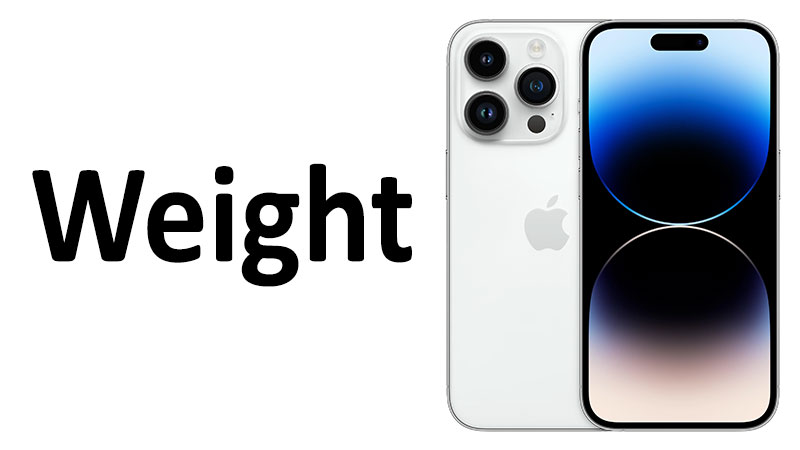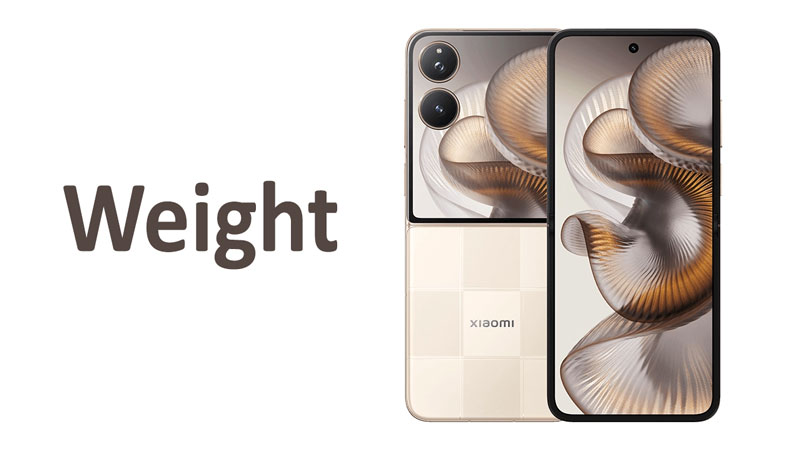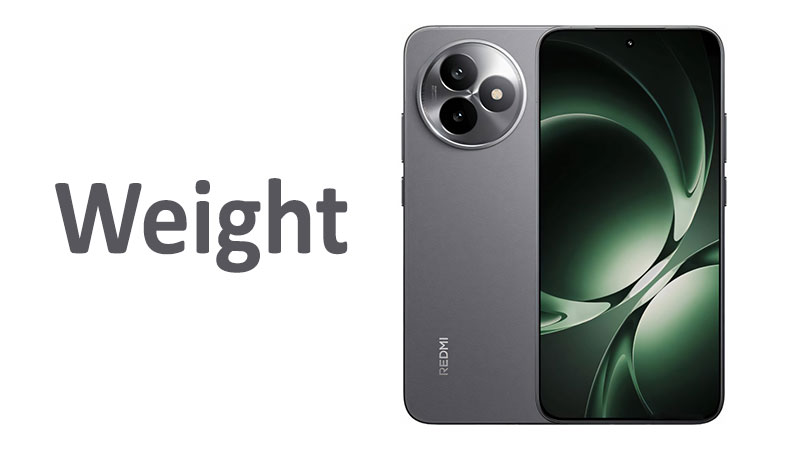The Apple iPhone 14 Pro weight is a crucial specification for consumers and a key factor in the device’s premium feel. Tipping the scales at exactly 206 grams (7.27 ounces), the iPhone 14 Pro established itself as a substantially built flagship device upon its release. This article provides a thorough analysis of this measurement. We will explore what contributes to this specific weight. We will also compare it to its predecessor, its sibling models, and major competitors in the smartphone market. This detailed examination helps buyers understand the ergonomic implications and the material science behind the device’s heft.
The Exact Apple iPhone 14 Pro Weight Specifications
The weight of a smartphone is a direct indicator of its internal components and external build materials. Understanding the exact figures and the units used for measurement is essential for making meaningful comparisons. The iPhone 14 Pro occupies a specific weight class that defines the premium category.
Grams vs. Ounces: Understanding the Metrics
Apple officially specifies the iPhone 14 Pro weight as 206 grams. This metric provides a universally recognized, precise standard of measurement used across the technology industry. For audiences accustomed to imperial units, this converts directly to 7.27 ounces.
It is helpful to remember that 206 grams sits notably higher than the weight of many standard-tier flagship phones. This significant mass suggests the inclusion of dense, high-quality materials. It also points to powerful, large internal components. Consumers often associate this specific heft with durability and high-end construction.
Factors Contributing to the Weight
Several key components contribute to the iPhone 14 Pro’s 206-gram mass. These components represent the device’s significant technological upgrades and its superior build quality compared to the standard iPhone models.
The primary contributor is the stainless steel frame. Unlike the aerospace-grade aluminum used in the standard iPhone 14, the stainless steel frame is inherently denser and therefore much heavier. This frame provides superior rigidity and resistance to bending. It is a signature feature of Apple’s Pro lineup from this generation.
The sophisticated camera system also adds considerable mass. The iPhone 14 Pro introduced a major upgrade to a 48-megapixel main sensor. This larger sensor required a physically larger lens system and optical image stabilization (OIS) hardware. The resulting camera module protrudes significantly from the back, adding density and weight to the top half of the phone.
The battery size is another essential factor. While the iPhone 14 Pro maintains a compact 6.1-inch form factor, it houses a battery designed to power the demanding A16 Bionic chip, the new Always-On display, and the ProMotion technology. The slightly increased capacity compared to the 13 Pro model also subtly nudges the overall weight upward.
Finally, the Ceramic Shield front cover and the precision-machined glass back panel contribute their share. These materials are chosen for their superior durability and scratch resistance. They are denser than standard consumer glass. Together, these elements explain why the iPhone 14 Pro carries its specific, premium weight.
Specialized Weight Comparisons: iPhone 14 Pro vs. Competitors
Analyzing the 206-gram weight in isolation provides little context. The true significance of the iPhone 14 Pro’s weight becomes clear only when comparing it directly against other models and competing devices. This helps identify trends in modern smartphone design.
Comparing with the iPhone 13 Pro (The Predecessor)
The weight of the iPhone 14 Pro (206g) represents a slight increase over its immediate predecessor, the iPhone 13 Pro (204g / 7.20oz). This difference of just 2 grams seems negligible on paper. However, it indicates that Apple was unable to reduce the weight despite maintaining the same core 6.1-inch size and stainless steel frame.
This minor increase primarily stems from the camera system enhancements and minor battery adjustments. For users upgrading from the 13 Pro, the difference in heft is virtually imperceptible in daily use. Both phones share the dense, reassuring feel characteristic of stainless steel construction.
Comparing with the iPhone 14 (The Standard Model)
The contrast between the iPhone 14 Pro and the standard iPhone 14 is far more dramatic and highlights the choice of build materials. The base iPhone 14 weighs significantly less, clocking in at 172 grams (6.07oz). This creates a substantial difference of 34 grams, or roughly 20 percent more weight in the Pro model.
The primary reason for this massive gap is the frame material. The standard iPhone 14 uses aluminum, a much lighter metal than the stainless steel of the Pro model. This comparison makes the 14 Pro feel notably denser and more robust. Buyers prioritize portability and lightness often prefer the standard iPhone 14 for this reason.
Comparing with the iPhone 15 Pro (The Successor)
The successor to the 14 Pro brought a revolutionary change directly addressing the weight issue. The iPhone 15 Pro adopted a new aerospace-grade titanium alloy for its frame, moving away from the heavy stainless steel.
This material change resulted in a substantial weight reduction. The iPhone 15 Pro weighs only 187 grams. This means the 14 Pro (206g) is 19 grams heavier than its successor. This difference is highly noticeable in the hand and represented a major design shift for Apple. The 14 Pro stands as one of the last compact Pro models to utilize the heavier stainless steel frame.
Comparing with Pro Max Models (14 Pro Max)
The iPhone 14 Pro Max offers the clearest benchmark for the upper limit of iPhone weight. The Pro Max model, with its larger 6.7-inch display and massive battery, weighs 240 grams (8.47 oz).
The 14 Pro (206g) is therefore 34 grams lighter than the Pro Max. This difference is significant enough to make the 14 Pro a true pocketable device, better suited for one-handed use and less taxing to carry for extended periods. The 14 Pro strikes a better balance between premium components and manageable ergonomics.
Comparing with Key Android Flagships
When comparing the iPhone 14 Pro’s 206g weight to contemporary Android flagships, it sits at the higher end of the compact flagship spectrum. For instance, the comparable Samsung Galaxy S23 model often weighed less, using aluminum frames.
However, the 14 Pro’s weight is comparable to or lighter than some of the largest, ultra-premium Android phones. While it is heavy for a 6.1-inch device, its weight is a statement about its construction. It signals a dedication to using materials like stainless steel for their aesthetic and durability benefits, even at the cost of lightness.
Pros and Cons of the iPhone 14 Pro’s Weight
The weight of a device is not a value that is strictly good or bad; rather, it represents a trade-off in design. The 206-gram mass of the iPhone 14 Pro brings both distinct advantages and notable drawbacks that potential buyers should consider.
Advantages: The Perception of Premium Build and Durability
The weight of the iPhone 14 Pro contributes significantly to its perception as a high-quality, premium product. A heavier phone feels substantial and sturdy in the hand. This weight is psychologically linked to better build quality. When a user holds the 14 Pro, the density of the stainless steel frame conveys an immediate sense of durability and reliability.
Furthermore, the extra mass can contribute to stability during photography and video recording. A heavier device resists minor hand shakes more effectively than a lighter one. This passive stabilization can be beneficial, particularly when shooting in low light or using the advanced 48MP main camera system. The robust materials that cause the weight, like stainless steel and Ceramic Shield, offer genuine physical protection against drops and impacts.
Disadvantages: Portability and Extended Use
The primary downside of the 206g weight is the impact on long-term comfort and portability. A weight of 7.27 ounces can lead to noticeable wrist fatigue during extended periods of one-handed use, such as continuous scrolling, reading, or gaming. This is a common complaint among users who switch from lighter aluminum-frame phones.
The overall physical bulk of the phone also increases. When combined with a protective case, the total carrying weight easily exceeds 250 grams. This combined weight can make the phone feel heavy in a pocket, particularly for tighter clothing or smaller bags. Users who frequently carry their phone in their hand or pocket must weigh this ergonomic trade-off against the perceived quality.
Essential Buyer and Reader Insights
Understanding the weight of the iPhone 14 Pro goes beyond a simple number. It involves appreciating the engineering choices Apple made and how those choices affect the phone’s handling and ownership experience.
Material Science: The Role of Stainless Steel
The choice of stainless steel for the iPhone 14 Pro frame is the single most defining element influencing its weight. Stainless steel is known for its high tensile strength and resistance to corrosion. It offers a mirror-like polish that aluminum cannot match, giving the Pro models their signature visual appeal.
However, stainless steel is approximately three times denser than aluminum. The iPhone 14, which has the same general size but uses aluminum, proves this point by being significantly lighter. The inclusion of stainless steel is an aesthetic and durability statement that inherently results in a heavier phone. This material choice is what differentiates the “Pro” build quality from the standard lineup.
Ergonomics and Hand Feel
The 206g weight is concentrated in a relatively small form factor (6.1 inches). This high density gives the iPhone 14 Pro a “brick-like” feel. While some users appreciate this solid heft, others find it too dense. The flat edges, a design element introduced in earlier models, exacerbate this feeling. These flat edges distribute pressure less evenly across the hand than rounded edges, potentially making the phone feel heavier than its actual weight might suggest.
To mitigate this, users frequently turn to accessories. The phone’s weight and shape encourage the use of PopSockets or other grips. These accessories improve grip security and shift the center of gravity, which reduces strain during prolonged use.
Impact on Accessories and Protection
Buyers must factor in the additional weight of a case when considering the iPhone 14 Pro. Most robust protective cases add between 30 and 60 grams to the total package. This pushes the total weight to well over 240 grams (8.5 ounces), matching or exceeding the weight of the larger 14 Pro Max without a case.
This is a critical consideration for those concerned about pocket carry and wrist fatigue. While a case is necessary to protect the phone’s glass front and back, it unavoidably transforms the 14 Pro from a moderately heavy phone into a genuinely heavy portable device. Thin, silicone cases add less weight, but they also compromise on the protective qualities.
The A16 Bionic and Advanced Features
The internal advancements also contribute to the density. The A16 Bionic chip, while a marvel of efficiency, requires sophisticated cooling mechanisms within the tight confines of the 6.1-inch body. The upgraded 48MP camera sensor, featuring second-generation sensor-shift optical image stabilization, represents a substantial piece of moving hardware. All these components require internal structures and stabilizers that collectively add grams. These performance and camera features directly justify the additional weight in the eyes of professional and enthusiast users.
Weight Distribution and Balance
It is important to note that the weight of the iPhone 14 Pro is not perfectly distributed. Due to the massive camera module, the weight is noticeably top-heavy. When holding the phone, users might feel the weight pull slightly toward the top edge. This uneven distribution can impact one-handed use, especially when trying to reach the Dynamic Island or notification center at the top of the screen. Users must adjust their grip to compensate for this slight imbalance, often relying on their pinky finger for support.
Resale Value Considerations
The 206-gram weight of the iPhone 14 Pro indirectly affects its long-term market perception. Because the successor model, the iPhone 15 Pro, significantly reduced its weight using titanium, the 14 Pro is now categorized as the “heavy” model in the compact Pro lineage. For some future buyers who prioritize lightness, this weight difference could slightly impact the 14 Pro’s resale value compared to the titanium models. However, other buyers continue to seek the stainless steel versions specifically for their substantial, robust feel, ensuring the 14 Pro retains appeal in the second-hand market.
Conclusion: Making an Informed Decision
The Apple iPhone 14 Pro weight of 206 grams (7.27 ounces) positions it firmly in the category of premium, densely built smartphones. This weight is a direct result of several high-end engineering choices, including the robust stainless steel frame, the large 48MP camera module, and the improved battery capacity.
The heaviness should not be seen as a flaw, but rather as a feature. It signals a superior physical build and enhanced durability. For the buyer who values a solid, high-quality feel and advanced camera technology, the 14 Pro’s weight is a justifiable trade-off for its premium construction.
However, buyers prioritizing maximum comfort, portability, and minimal strain during long usage sessions should consider the weight carefully. They might find the lighter standard iPhone 14 or the newer, titanium-framed iPhone 15 Pro to be a better ergonomic fit. The 14 Pro remains an exceptional device that offers a satisfying, substantial heft that many users associate with true flagship quality.
Frequently Asked Questions (FAQ)
Is the iPhone 14 Pro heavier than the iPhone 13 Pro?
Yes, the iPhone 14 Pro is marginally heavier than the iPhone 13 Pro. The 14 Pro weighs 206 grams, while the 13 Pro weighs 204 grams. This 2-gram difference is minor and stems from the newer, larger camera sensor and related internal structural changes.
Does the Dynamic Island add to the weight of the phone?
No, the Dynamic Island itself does not add significant weight. It is a new software experience combined with a smaller, pill-shaped cutout replacing the notch. The hardware required for this, such as moving the proximity sensor, did not substantially affect the overall mass of the device.
How does the weight of the iPhone 14 Pro affect one-handed use?
The 206-gram weight can make the iPhone 14 Pro feel dense, potentially causing wrist or finger strain during prolonged, one-handed use. Users with smaller hands or those who read for hours may find it tiring without using a grip accessory or adjusting their grip frequently.
Is 206 grams considered heavy for a flagship phone?
For a compact 6.1-inch flagship phone, 206 grams is considered quite heavy. The weight is typical of larger devices or phones built with stainless steel, like the 14 Pro. Many comparable phones utilizing aluminum frames weigh significantly less, often closer to 170 to 180 grams.
Does adding a case significantly increase the total weight?
Yes, adding a typical protective case, especially a rugged or battery-enabled one, increases the total carrying weight substantially. A standard protective case can add 30 to 60 grams, pushing the combined weight well over 240 grams, comparable to the naked weight of the 14 Pro Max.



